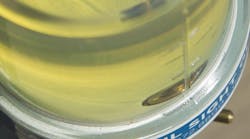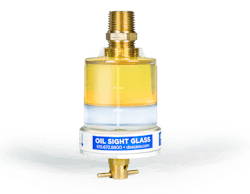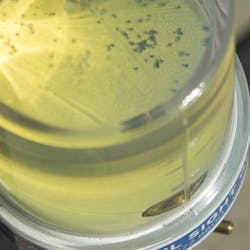The lowly sight glass has been used for generations as a quick and easy method to ensure that fluid level in a hydraulic reservoir, gearbox, or transmission housing is at an acceptable level. Des-Case Corp., Goodletsville, Tenn., does the sight glass one better with its redesigned oil sight glass (OSG).
Most OSGs have clear bottoms making it more difficult to visually detect the presence of sediment in oil. Des-Case’s new OSG has a white bottom that makes detection far easier and more reliable. The redesigned device also has a dual mount versatility for use in both horizontal and vertical applications, eliminating the need to buy two single-orientation OSGs. And the sight glass’ polyamide casing not only provides a clear view of the oil, but is strong enough to withstand impacts.
“We challenged our engineers to reimagine how an oil sight glass can increase the visibility, durability, and versatility of the process of visual oil analysis.” Said Brian Gleason, CEO of Des-Dase. “Working closely with our customers, manufacturing team, and other industry experts, they have designed what is truly the next generation of the oil sight glass.”
Undoubtedly, the most important improvement in the new Des-Case oil sight glass is the improved visibility in detecting machine wear and contamination. Other improvements include a sloped floor for better sediment drainage, indication marks to easily monitor accumulation of water, and improved UV resistance and compatibility with all gear and mineral oils, most synthetic oils and diesel.
“By using OSGs in combination with a desiccant breather and proper filtration, reliability and maintenance professionals can provide the ultimate protection and long life for machinery,” said Gleason. And by using Des-Case’s reimagined OSG, they’ll have the latest generation of engineering and technology that will ensure greater reliability for their plants and equipment.”




